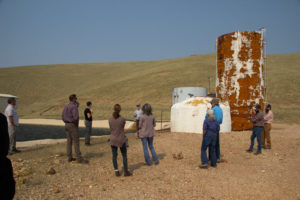By Derf Johnson

Last September, at the invitation of the Fort Belknap Indian Community (FBIC), MEIC’s Katy Spence and I joined a number of Tribal members, conservation organizations, and staff from the Montana Department of Environmental Quality (DEQ), to tour the defunct Zortman-Landusky mine site in the Little Rockies of north-central Montana. Much has been written about the travesty of the Zortman-Landusky mining complex (see the story in the Sept. 2021 issue of Down to Earth). We saw the mine site and the environmental problems it is causing firsthand. That provided the necessary context and scale to more fully understand the devastation that Pegasus wrought on the Little Rockies and on the FBIC. Tribal members and resource managers shared their concerns and asked questions of DEQ, providing a human face to the devastation. The sheer scale of damage to the land was shocking, as was seeing the water treatment plants that will forever need to treat the contaminated water in the area at public expense.
This experience further solidified MEIC’s strong opposition to a proposed mining venture that is attempting to conduct exploration activities right smack dab in the center of the reclamation area of the Zortman-Landusky mines. Over the past year, a company known as Blue Arc has submitted a series of applications to DEQ seeking a permit to conduct mining exploration activities. Unfortunately, its first application was approved by DEQ and is awaiting a bond to be posted before exploration can begin. However, the FBIC, MEIC, and a number of environmental group partners have challenged the permit in court, and will continue to litigate our concerns with the permit should the bond be posted.
The fourth and latest proposal by Blue Arc that would allow the company to conduct exploration raises a number of concerns, including the possibility of damaging ongoing reclamation activities, exacerbating the already extensive problems associated with acid mine drainage, and impacting cultural resources. Up to this point, DEQ’s process on Blue Arc’s mining proposals has been unremarkable. That is to say, the review has been largely formulaic. In this instance, I expected the usual from DEQ – that it would issue a draft permit, conduct the requisite (though incomplete) environmental analysis, and accept comments before approving the permit.
Remarkably, instead of a rubber stamp, DEQ decided to produce a full environmental impact statement to more adequately assess the potential environmental harm associated with any mine exploration in the Little Rockies. Let’s give credit where credit is due – DEQ deserves recognition for this decision. Notably, Tribal members spoke passionately at a public hearing about the exploration permit, voicing concerns about further mining in a place that is incredibly important for the social fabric and cultural underpinnings of their Tribe. DEQ listened this time, recognizing that the project posed serious concerns for the Tribe and the environment. We hope this represents a new approach for DEQ to actually listen to impacted Tribes.
In response to criticism from Luke Ployhar, one of the permittees, FBIC President Jeffrey Stiffarm submitted a statement to state newspapers. In it, Stiffarm explained the importance of the Little Rockies and the dangers of further mining. While we recommend reading the entire statement, here is an excerpt:
The legacy of gold mining in the Little Rockies has been devastating to our people from both cultural and environmental perspectives. Therefore, our tribes have steadfastly resisted more mining ever since federal agents and gold-mining interests took the “Grinnell Notch” portion of the lands in the Little Rockies, promised to us in our solemn treaties with the United States in 1896, under express threat of starving our families and children if we did not agree to the land cession.
This grim history is recounted in numerous contemporaneous Congressional reports. But despite that deadly threat, only 37 Gros Ventres consented to the 1896 cession. This was because our land, and especially our mountains, are the foundation of our cultural practices. The Little Rockies are home to many of our sacred sites and cultural ceremonies. They are the place we go to fast, to pray, to engage in spiritual communion.
We endured the grave injustice of the loss of the Grinnell Notch, which was sliced and diced in various private land transactions thereafter. One such transaction resulted in Ployhar being able to pay a substantial sum of money for a property roughly 20 years ago, easily outbidding our poor tribes. He now seeks to explore gold mining on the property notwithstanding near universal local opposition to his proposals.
Happily, Gov. Greg Gianforte’s Administration and the Montana Department of Environmental Quality have heard our concerns and pledged to follow Montana’s environmental laws requiring deeper professional analysis of Ployhar’s proposals. This is a major change from past mining permitting in the area, where tribal concerns were ignored and proper methods of identification of cultural sites were not followed.
This article was published in the March 2022 issue of Down To Earth.

